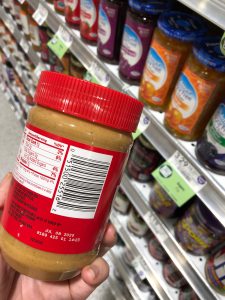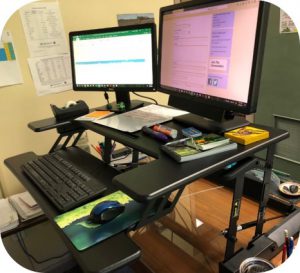
by Amy Mullins, PhD, RDN | Feb 11, 2019

Make SMART changes for your health. Photo credit: UF/IFAS Northwest District
“New Year, New Me!” – the same phrase we hear and see posted all over social media every time the new year rolls around. More often than not, resolutions tied to each new year involve diet and weight changes. But how does one actually commit to these new resolutions year round?
Step 1: Forget Fads and “Dieting”
The world of nutrition can seem overwhelming with the various diets that are continuously marketed as “the next best thing for your health.” However, most diets, such as Paleo, Vegan/Vegetarianism, Keto, etc., exclude one or more food groups from the diet, which only makes things more challenging. In reality, eating healthy does not need to be that difficult. According to the 2015-2020 Dietary Guidelines for Americans, a healthy eating pattern “accounts for ALL foods and beverages within an appropriate calorie level.” Essentially, moderation is key!
In addition to fads, scratch the word “diet” from your vocabulary. Dieting implies something short term or there is an end date in mind. To build healthy, sustainable eating patterns, we want to make lifestyle changes. A healthy lifestyle not only incorporates what you eat, but includes exercise and a healthy mind as well! Use SMART goals to help attain your healthy eating/lifestyle changes for 2019: SMART stands for Specific, Measurable, Achievable, Relevant, & Time-bound.
Step 2: Focus on Food Groups
Instead of counting calories in 2019, let us count food groups! How many food groups does your meal have? Is there a protein? Vegetables? Healthy fats? Foods are generally classified into three main groups, or macronutrients. By definition, macronutrients are types of food required in large amounts in the diet. Such foods are proteins, carbohydrates, and fats.
Proteins include all types of meats such as chicken, turkey, fish, and beef. Other foods high in protein include eggs, dairy products, legumes (peas and beans), various nuts, and soy products. Proteins are the basic building blocks of your bones, muscles, skin, and blood. Your body uses proteins to build and repair your tissues and it is an essential nutrient for the human body. Strive to include a rich source of protein at every main meal! How much protein do you need? Aim to include 20-30 grams, or 4-6 ounces, at every main meal. That is the equivalent of a chicken breast that is about the size of a deck of cards or the palm of your hand.
Carbohydrates include simple sugars, all types of grains, fruits, and vegetables. Carbohydrates are the body’s main source of and preferred fuel for daily activities. It may be somewhat confusing as to what are appropriate carbohydrates to add in your diet. To simplify things, aim to include at least two different carbohydrates in your meal. Perhaps that includes a grain (aim to make half of all your grains whole grains) plus a variety of vegetables. If you really want to add a cookie to your lunch, then make sure to include some fruit or vegetables as well!
Fats are a food group that often carry a negative reputation. However, fat plays an essential role as an ingredient in hormone production, in helping to protect our organs, absorption of vitamins and nutrients, as well as providing a good amount of energy! Fats are subdivided into four groups: Monounsaturated, polyunsaturated, saturated, and trans fats. The word unsaturated indicates that these types of fats are liquid at room temperature and make up much of our healthy fats we want to include in our diet. Such fats are those found in olive oils, avocados, nuts, and seed oils and reduce the risk of cardiovascular disease. Saturated fats are solid at room temperature, and include butter, cheese, and fatty streaks you find in meats. Trans fats are a manufactured form of fat in which food manufacturers add hydrogen to liquid fats in order to make them more solid. Trans fats have been known to increase LDLs or bad cholesterol, decrease good cholesterol or HDLs, and are linked to an increased risk for cardiovascular disease and type 2 diabetes. According to the American Heart Association and 2015-2020 Dietary Guidelines for Americans, we want to limit trans and saturated fats in our diets and focus on including more oils, nuts, and fish.
Step 3: Make Small, Adaptable Changes
If you are used to consuming large amounts of processed foods and sugary beverages, the thought of completely giving up those things can be very daunting. Implementing new strategies to eat healthier begins with small and adaptable changes. Slow incorporation of more lean meats and fresh fruits and vegetables can help make the transition far less challenging.
For example, most often, macaroni and cheese is made with white pasta and high fat cheese. To modify this meal and make it healthier, try substituting whole grain pasta for regular pasta. Next, experiment by adding some of your favorite vegetables and a lean protein such as chicken or tuna. Look for 2% or low fat cheese in the grocery store to replace the regular high fat version. These simple changes will allow you to still enjoy your favorite meal, reduce the sodium and fat content, and increase your consumption of vegetables and proteins!
Small subtle changes are key to creating long-term healthy habits. The transition to building healthier eating patterns will be much easier if you shift the focus to include more of what our bodies need and less on “dieting.” If you find yourself struggling to make healthier meals, https://www.choosemyplate.gov/MyPlate is a great resource to educate yourself on how to build and maintain a healthy diet!

by Amy Mullins, PhD, RDN | Aug 24, 2018

Photo source: UF/IFAS Northwest District
If your family is like most, grocery shopping is a dreaded weekly task. Typical shoppers usually have an idea of what they plan to purchase based on a previously made shopping list. Even then, it’s easy to go astray with impulse purchasing, bargain prices, and buy-one-get-one free opportunities that simply can’t be passed up! Before you know it, the shopping cart is loaded with delicious treasures just begging to come home with you.
Now that you have done the shopping, transported it home, and begun to put food items in their appropriate storage places, you realize the refrigerator, freezer, and pantry are cramped and nearly full. On a related aside, you should see my parents’ pantry. They have enough cans, boxes, and packages to feed their entire neighborhood…twice! Not to mention the two full size refrigerator/freezers that are bursting at the seams. Like my parents, I suspect many of us have a food overbuying addiction. So what happens next? Well, it’s time to clear out the old and make way for the new, of course. But how do you know what to purge and what is still good to keep?
Food Date Labeling Confusion and Food Waste
Standard or uniform language for food product dating does not exist in the U.S., which makes things tricky when it comes to deciphering expiration dates. Current Federal regulations do not require product dating (excluding infant formula), but instead allow food manufacturers to voluntarily set and display these dates on product packaging. With the lack of Federal measures, product dating enforcement is left up to individual states, resulting in consumer confusion over food safety. The U.S. wastes close to an estimated 40% of food produced annually, which equals approximately 160 billion pounds (Harvard Food Law and Policy Clinic). Of that, confusion over the meaning of date labels seems to be responsible for roughly 20% of safe and edible food wasted by consumers. Undoubtedly, this hurts purchaser’s pocketbooks and results in $29,000,000,000 of wasted consumer spending yearly (Food Date Labeling Act of 2016, 114th Congress 2D Session).
Food Quality vs. Food Safety
While cleaning out the pantry and cold storage, I also have been guilty of trashing perfectly good food. So many of us unknowingly accept the stamped date as common law not to be questioned. So what does that date actually mean?
The “open” date used by the manufacturer or retailer on food packaging is passively thought of by the consumer as the “expiration date,” or the last date a food can safely be eaten. This is a very common misconception. Food safety is not represented by this date, but rather it refers to product quality and freshness. Dates determined by food companies take into consideration such factors as ingredients, product characteristics and packaging, as well as time and temperatures associated with distribution, retail sale, and storage.
With no current standards in place, a variety of food date phrases are utilized which often are misleading to retailers and consumers. Most commonly used phrases include:
- “Best If Used By/Before” indicates when a product will be of best flavor or quality.
- “Sell-By” indicates to the retailer when the product should no longer be displayed for sale.
- “Use-By” is the last date recommended for use of the product at peak quality. This is only a safety date when used on infant formula packaging.
It’s important to remember that open dates on food products ONLY reflect food quality and NOT food safety (except for infant formula). For a list of specific foods and recommended storage time frames, check out the FoodKeeper resource at FoodSafety.gov.
Food Spoilage
Knowing the signs of spoilage will help you determine if a food is no longer fit for consumption. Although the quality date may have passed, the food is safe until it begins to spoil. Spoiled food may have a different smell, taste, and/or texture with sometimes visible discoloration. This occurs when environmental conditions (such as temperature, moisture, and oxygen) are introduced which support the growth of bacteria, molds, or yeasts. Given enough time, these microorganisms multiply rapidly and affect the safety of the food. If perishable items are not handled and stored properly, spoilage occurs much more rapidly. Learn more about proper refrigeration and food safety.
Do Your Part at Home
- Plan meals in advance and make a specific grocery list. Check the refrigerator, freezer, and pantry to utilize what you already have on hand.
- Don’t overbuy! Especially be aware not to purchase excess perishable items that are likely to spoil quickly. These may be foods that require cold storage, fresh bakery items, and fresh produce.
- Always look for and compare date labels of an item; choose the one with a later date.
- Store foods promptly and properly for food safety and best quality. Discard potentially hazardous cold food items that have not been properly refrigerated for 2 hours or more.
- Keep a thermometer inside the front of your refrigerator and check it regularly to be sure it stays below 40 degrees F.
- Thaw foods safely! Thawing in the refrigerator is the safest way, but using cold running water or defrosting in the microwave are acceptable ways to speed up the process. Never sit foods out at room temperature to thaw!
- Recognize the signs of food spoilage and promptly discard foods that smell funny, have off-flavors, obvious mold growth, or sticky or slimy textures (such as fish, poultry, and deli meats).
- Evaluate each item in your pantry and consider whether or not it’s something you want to continue to store and use or want to remove.
- High temperatures affect the shelf life of shelf-stable foods so it’s important to store dry goods and pantry items in temperatures at or below 85 degrees F. Use the “First In First Out” (FIFO) method of rotation, using older items before newly purchased ones. Read more about Shelf Stable Food Safety.
- Discard cans that are rusty, bulging, or leaking, as they are at a high risk for containing the deadly pathogen that causes Botulism. Never taste suspicious foods! Take extra caution by disposing of cans and jars into a tightly closed plastic bag before placing in an outside trash receptacle.
Help Families in Need & Keep Unused Wholesome Food Out of Landfills
Mistakenly discarded food products, not only is the U.S. but globally, have created a sad cascade of wasted resources and money with increasingly negative environmental and social implications. Food banks and local community organizations have plenty of under-served and needy families who can benefit! Remember, it’s safe to donate dry and canned goods, perishables, and other food related items that are beyond the quality date of the product.
Find a food bank near you.
We all can do our part to reduce the amount of wasted food, save money, help the environment, and help our communities!
Additional Resources:
https://www.usda.gov/oce/foodwaste/sources.htm
https://www.usda.gov/oce/foodwaste/resources/donations.htm
USDA Food Safety Information, Food Product Dating
USDA Food Labeling Fact Sheets

by Amy Mullins, PhD, RDN | Jul 26, 2018

Get out of your chair. Photo source: Amy Mullins
Have you ever thought about how many hours a day you spend sitting? Sitting at your desk, sitting in front of a computer, sitting watching television, sitting in the car, sitting, sitting, sitting. On average, Americans sit approximately 13 hours a day and sleep 8 hours adding up to a whopping 21 hours of inactivity. All of this sitting around may in fact be shortening our lives.
The cumulative effect of daily inactivity, or sedentary time, has contributed to a nationwide crisis of escalating chronic health conditions that include obesity, heart disease, high blood pressure, stroke, certain cancers, and type-2 diabetes. According to research, including a 2014 Harvard study of over 92,000 women, the risk of dying from stroke, heart disease, and cancer increases with the more time spent standing. In addition, the negative effects of excessive sitting seem to be just as strong in people that participated in a regular exercise regimen!
Standing Has Many Benefits
Our bodies increase a fat-burning enzyme called Lipoprotein Lipase when muscles are activated. This doesn’t just happen during purposeful exercise, but even during periods of standing. In fact, standing burns 30% more calories than sitting still! Regular engagement of muscles keeps them in a more continuous metabolic state that helps improve blood cholesterol, blood pressure, and blood sugar levels. Regular intervals of standing with minimal movement does all of this and so much more:
- Improves posture
- Tones muscles
- Increases blood flow
- Improves metabolism
- Improves mood
- Increases mental energy
- Reduces fatigue
During a typical day at work, experts recommend not sitting for more than 20 minutes at a time with regular intervals of standing. Standing up and walking even for just 5 minutes can lift your mood, increase mental energy and productivity, and can even dull your urge for unnecessary snacking.
What You Can Do

Standing desk. Photo source: Amy Mullins
Get up and move more! Consider some of these ideas to help in your quest to be more active during the day:
- Create a culture of health and encourage others in your workplace to support one another.
- Purchase a “standing desk” or get creative and make one to meet your needs
- Use a smartphone app, wrist monitoring device (such as a FitBit), or just an alarm on your phone or desktop to remind you to stand up and stretch or to walk outside for some fresh air.
- Instead of emailing or calling a co-worker, get up and take a stroll down the hall.
- On a conference call? Stand, move, stretch, do squats or desk push-ups.
- Take the stairs as often as you can.
- Forget hum-drum meetings in the conference room! Get creative on your feet and schedule walking meetings.
- Skip the afternoon coffee and energize with some office exercises. Consider getting an exercise mat, resistance band, stability ball and light weights.
- Wear comfortable shoes and clothing to the office and enjoy part of your lunch break taking a brisk walk and/or stretching.
- Bring your own reusable bottle to work and drink more water throughout the day. More water means more times you’ll have to walk to the restroom!
It’s not easy to create positive habits, but your health is worth it. But, making even a few changes to your normal routine can put you on a path to a happier and healthier life. For additional information about healthy habits in the workplace, visit:
NIH U.S. National Library of Medicine
U.S. Division of Occupational Health and Safety
CDC Workplace Health Promotion
University of Michigan Computer Ergonomics

by Amy Mullins, PhD, RDN | Apr 26, 2018

photo credit: Amy Mullins, UF IFAS Leon County Extension
Have you ever imagined planting a small garden and growing vegetables for your family? It may seem like a difficult and daunting project, but I assure you the benefits of growing your own vegetables far outweigh the reservations and roadblocks that may have previously stood in your way. Among these benefits include increased physical activity, stress relief, better mental health, and better nutrition. Consuming a diet rich in produce can reduce overall calorie consumption and provide a variety of nutrients to minimize the risk of developing chronic diseases associated with overweight and obesity.
Growing your own vegetables and herbs in the best way to “eat locally”! The convenience of having what you need for fresh salads, soups, and sides right outside your door can enable you and your family to have a healthier diet. And did you know that when children are involved in the gardening process, they are actually more likely to increase their consumption of fruits and vegetables? Pull the kids off the couch and get whole family involved in garden planning, planting, maintaining, harvesting, and cooking.
Spring is the time to plant beans, cucumbers, eggplant, melons, okra, field peas, peppers, summer and winter squash, sweet potatoes, and tomatoes. Just think of all the possibilities for an abundance of healthy eating this summer!
Getting started is easy. Check out these UF IFAS resources to help get you on the right path to growing your own produce:
Edible Landscaping
Florida Vegetable Gardening Guide
Plant These Spring Herbs
Produce Pointers Recipes
by Amy Mullins, PhD, RDN | Oct 26, 2017
 We all have family traditions that make our holiday celebrations special. From your great-great-grandma’s sweet potato casserole or pecan pie, to your mother-in-law’s sausage stuffing or decadent plum pudding, there’s one thing that always seems to be a common factor among traditional holiday dishes: a massive amount of, fat, sugar, salt, and calories!
We all have family traditions that make our holiday celebrations special. From your great-great-grandma’s sweet potato casserole or pecan pie, to your mother-in-law’s sausage stuffing or decadent plum pudding, there’s one thing that always seems to be a common factor among traditional holiday dishes: a massive amount of, fat, sugar, salt, and calories!
It’s not only a single meal but rather an entire season of parties, events, gatherings festivities, and unhealthy choices that add up to that holiday weight gain we resolve to lose when January rolls around. As the holiday season begins its rapid approach, take time and consider those past eating habits that set your new year off on the wrong foot. Why not make a resolution now to eat healthier this holiday season?
Just a few simple strategies can help make the difference and keep those unwanted pounds away. Here are some suggestions:
- Don’t skip meals. Eating healthy on a regular basis will keep you from overindulging at holiday gatherings.
- Use smaller plates for meals and gatherings and be mindful of portions
- Choose more vegetables and smaller helpings of entrees and desserts
- Drink more water and minimize alcoholic drinks and eggnog
- Make healthier recipe ingredient substitutions when cooking and baking (Mayo Clinic):
- Instead of heavy cream, use fat free half and half or evaporated skim milk
- Instead of bacon, try Canadian bacon, turkey bacon or smoked turkey
- Decrease sugar in baked goods by half and add vanilla, nutmeg, or cinnamon to intensify sweetness
- Substitute applesauce or prune puree for half of the butter, shortening, or oil
- Use two egg whites or ¼ cup egg substitute for each whole egg
- Replace salt with fresh or dried herbs and spices.
We can all still experience the joy of the holiday season, without making food the focus. Make a resolution to be mindful and eat healthier this holiday season, and your waistline will thank you.
Some additional links that you may find helpful:
https://healthyforgood.heart.org/eat-smart/articles/holidays-healthy-eating-guide
https://www.cdc.gov/features/HealthyResolutions/
https://choosemyplate-prod.azureedge.net/sites/default/files/printablematerials/2013-HolidayMakeover.pdf
https://www.mayoclinic.org/healthy-lifestyle/nutrition-and-healthy-eating/in-depth/healthy-recipes/art-20047195?p=1










